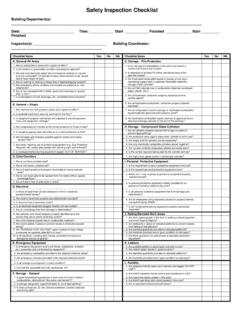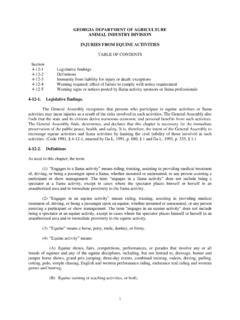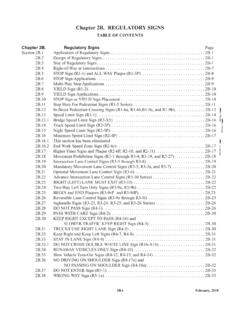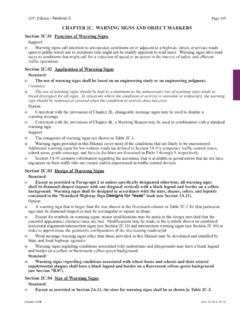Transcription of Chapter 4 WORKING SAFELY WITH BIOHAZARDOUS …
1 18 Chapter 4 Last Update 8/9/2013 Chapter 4 WORKING SAFELY with BIOHAZARDOUS MATERIALS This Chapter contains guidance on WORKING SAFELY with BIOHAZARDOUS materials. Emphasis is placed on integrating biosafety practices and procedures with standard laboratory operations. Classification of biosafety levels is included in this Chapter . Basic Biosafety Practices Persons WORKING with BIOHAZARDOUS materials must be aware of potential hazards and must be trained and proficient in specific safety practices and techniques.
2 The following biosafety practices are fundamental in using BIOHAZARDOUS materials SAFELY : Identify and evaluate BIOHAZARDOUS material exposure risk. Research laboratory procedures or techniques must be designed to SAFELY handle BIOHAZARDOUS material and anticipate the worst-case exposure potential. Knowing how infectious organisms are transmitted (aerosol, ingestion, dermal, injection), organism infectious dose, and types of laboratory activities (centrifuging, pipetting, shaking, vortexing, sonicating, opening containers of infectious materials, necropsy, etc.)
3 Can help to evaluate potential risks and avoid infection. Information about the organism(s) and activities must be gathered prior to commencing work. Refer to Sections and If human blood, tissue or cell lines are part of your research activities, follow the template in Appendix F to develop your specific laboratory exposure control plan (refer to ). Attend required EHS biosafety training as well as complete lab specific training with PI. Proficiency in laboratory practices (training provided by PI). Refer to Section , Appendix O. Know where information resources for BIOHAZARDOUS materials can be found.
4 Collect and communicate all the facts and information resources for BIOHAZARDOUS materials to appropriate personnel to minimize exposure risk. Refer to Chapter 2 and the Appendix O of this manual. Make sure all biohazard signs and labels are present. Post appropriate biohazard signs and labels to assure only authorized personnel, informed of potential risks, enter areas where BIOHAZARDOUS material are used. Any equipment where BIOHAZARDOUS materials are used or stored must be labeled. Refer to Section of this manual. Utilize appropriate safety equipment and facility design for the Biosafety level.
5 Primary containment safety equipment, such as biological safety cabinets, is designed to reduce or eliminate exposure to BIOHAZARDOUS materials. Secondary containment facility design is intended to contain BIOHAZARDOUS materials in the laboratory so that they cannot cause harm to the general public or the environment. Refer to Sections and of this manual. Maintain good housekeeping and personal hygiene. Good housekeeping is the most important step to improve safety. Good housekeeping also leaves a good impression upon visitors. Floors, laboratory benches, equipment, and other surfaces should be disinfected routinely.
6 All BIOHAZARDOUS material waste should be autoclaved, sterilized, or placed in a biohazard Unwanted Materials container for disposal. Refer to Appendix G of this manual. Personal hygiene, such as frequent hand and laboratory clothes washing, should be observed at all times. Refer to Section and Appendices E and F of this manual. 19 Chapter 4 Last Update 8/9/2013 Biosafety Principles and Concepts The purpose of this section is to provide definitions of biosafety concepts. Pathogenicity or Virulence Pathogenicity or virulence is the ability of a BIOHAZARDOUS material to produce or develop a rapid, severe, or deadly disease.
7 Some materials are highly pathogenic, even in healthy adults, whereas others are opportunistic pathogens able to infect only hosts with lowered immunity or sites other than their normal habitat. Some BIOHAZARDOUS materials are attenuated, or weakened, and do not produce significant disease. The more severe the health consequences of a potentially acquired disease, the higher the risks. Routes of Entry An infection occurs when pathogenic microorganisms enter the human body in sufficient numbers and by a particular route which overcomes the body s defense system.
8 By understanding the mode of transmission (pathway from source to you) and route of entry (entry route into body), procedures or controls to prevent exposure and infection can be developed. Inhalation hazards: Inhalation of aerosolized BIOHAZARDOUS materials is the most common route of entry into the body. Inhalation of aerosols involves microscopic solid or liquid particles small enough to remain dispersed and suspended in air for long periods of time. Sources of aerosols include: Aerosolized solid material (spores, dust, particulate, etc.). Liquid material (mists and sprays, coughing, spittle, sputum, etc.)
9 Technical process (blending, grinding, sonicating, lyophilizing, sawing, centrifuging, etc). Ingestion hazards: Ingestion of BIOHAZARDOUS materials occurs frequently as the result of poor personal hygiene and poor laboratory practice. Proper hand washing minimizes the opportunity for mouth and eye exposures. Examples of how ingestion occurs include: Eating, drinking, and smoking in laboratory Mouth pipetting and suction techniques Transfer of microbes to mouth by contaminated fingers or articles Direct (Skin/Eye) Contact hazards: Direct contact to BIOHAZARDOUS materials occurs through cross-contamination and mucous membrane exposure including the skin, eyes, inside of the mouth, nose, and the genitals.
10 The main avenues by which BIOHAZARDOUS materials enter the body through the skin are hair follicles, sebaceous glands, sweat glands, and cuts or abrasions. Examples of how direct contact occurs include: Splash or spray of BIOHAZARDOUS material onto skin, eye, mouth, or nose Handling contaminated equipment with unprotected non-intact skin Transfer or rubbing by contaminated fingers or gloved hand Applying cosmetics or contact lens in laboratory Injection or inoculation hazards: Inoculation or injection occurs when BIOHAZARDOUS material is accidentally introduced into the body with contaminated objects through the intact skin barrier.











